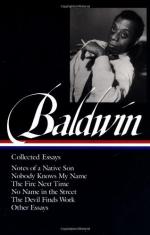
|
| Name: _________________________ | Period: ___________________ |
This test consists of 15 multiple choice questions and 5 short answer questions.
Multiple Choice Questions
1. How does Baldwin describe the relationship between the Negroes and the Jews in Harlem?
(a) Contentious.
(b) Amicable.
(c) Indifferent.
(d) Unwanted.
2. Who was the representative of the Progressive Party in Atlanta?
(a) Mrs. Branson Price.
(b) Mrs. Dorothy Dandridge.
(c) Mrs. Frank Johnson.
(d) Mr. Henry Wallace.
3. In what year was the all-Black production of Carmen Jones released?
(a) 1951.
(b) 1955.
(c) 1957.
(d) 1954.
4. What was the name of the establishment where the Melodeers ate their meals while in Atlanta?
(a) Fraziers' Diner.
(b) Hunter Street Café.
(c) Red's Diner.
(d) Fraziers' Café.
5. Since Negroes have been in this country, Baldwin writes that their one devastating gain was:
(a) Emancipation.
(b) Slavery.
(c) Colonization.
(d) Abolition.
6. How does Baldwin describe literature on the subject of the Negro in America when it is written by Blacks?
(a) Social Literature.
(b) Protest Literature.
(c) Problem Literature.
(d) Change Literature.
7. Who is the author of Uncle Tom's Cabin?
(a) Harriet Beecher Stowe.
(b) George S. Schuyler.
(c) James Baldwin.
(d) Richard Wright.
8. What genre of film is the movie Carmen Jones?
(a) Horror.
(b) Opera.
(c) Comedy.
(d) Drama .
9. What is the setting of the opening of Native Son?
(a) A Harlem apartment.
(b) A YMCA in Atlanta, GA.
(c) The projects of the Bronx, NY.
(d) A Chicago tenement.
10. Why did Baldwin think the Negro vote was so easily bought and sold in the 1940s?
(a) Because Blacks did care about politics.
(b) Because Blacks were in need of money.
(c) Because Whites has a great influence in Black politics.
(d) Because it was treated with little respect.
11. How is the Negro in America referred to in the chapter entitled Many Thousands Gone?
(a) A mass of darkness.
(b) A series of mishaps.
(c) A gloomy mist.
(d) A series of shadows.
12. What Hollywood studio produced the film Carmen Jones?
(a) Universal Studios.
(b) Twentieth Century Fox.
(c) MGM Studios.
(d) Walt Disney Studios.
13. What type of accommodations were promised to the Melodeers prior to leaving for Atlanta?
(a) Four to a room.
(b) One to a room.
(c) Dormitory style accommodations.
(d) Two to a room.
14. Where did the Melodeers room while in Atlanta?
(a) The homes of Progressive Party members.
(b) YMCA.
(c) a Negro motel.
(d) YWCA.
15. According to Baldwin, at what point does the making of an American begin?
(a) At the point where the individual rejects all other ties and history to other nations and receives their U.S. citizenship from the government.
(b) At the point where the individual rejects all other ties and history to other nations and adopts the venture of the adopted land.
(c) At the point where the individual reaches Ellis Island in New York.
(d) At the point that the person enters the country and adopts the venture of the adopted land.
Short Answer Questions
1. What is the theme of Baldwin's Notes of a Native Son?
2. Why does Baldwin criticize the book Native Son?
3. What was the aim of the quartet groups like the Melodeers?
4. Where is Harlem located?
5. In what era did James Baldwin write Notes of a Native Son?
|
This section contains 557 words (approx. 2 pages at 300 words per page) |

|




